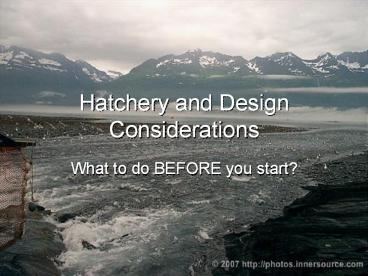Hatchery and Design Considerations PowerPoint PPT Presentation
1 / 22
Title: Hatchery and Design Considerations
1
Hatchery and Design Considerations
- What to do BEFORE you start?
2
(No Transcript)
3
Lecture 1 Farm Site Selection
- Objectives
- Proper approach to site selection
conceptualization - Good vs. bad information
- Water quality criteria, source capacity, tidal
issues - Soil (part 2) texture, chemical properties
- Vegetation, climatic, other determinants
- Evaluation process (part 3)
4
Conceptualizing the Site
- WHAT WENT WRONG?
- IMPROPER SITE SELECTION
- INAPPROPRIATE ENGINEERING
- INADEQUATE FINANCING
- INEFFECTIVE HUSBANDRY
5
SITE SELECTION IS CRITICAL..IT CAN DETERMINE
- LOAN POTENTIAL
- ENGINEERING LAYOUT/DESIGNS
- LEVEL OF EQUIPMENT REDUNDANCY
- PRODUCTION METHODOLOGY
- BUSINESS STRATEGY
- MARKETING/SALES STRATEGY
6
WHY "BAD" SITES ARE SELECTEDALL THE WRONG
REASONS!
- "THE LAND PRICE WAS A BARGAIN"
- "THE GOVERNMENT WAS JUST GIVING IT AWAY"
- "HEY, IT WAS NEAR THE WATER!"
- "BUT THERE WERE OTHER FARMERS NEARBY.."
- "NOBODY ELSE WANTED IT"
7
CONCEPTUALIZE THE SITEWHAT CONSTITUTES A SITE?
- A PIECE OF LAND? COAST? COUNTRY?
- A SPECIFIC PROFIT CENTER?
- A SPECIFIC PRODUCT?
- SOCIAL OR ENVIRONMENTAL MISSION?
8
ASSUMPTIONS
- STRANGER IN A STRANGE LAND
- PLAN TO UTILIZE EVERY INCENTIVE
- STRIVING FOR VERTICAL INTEGRATION
9
DISCLAIMERS
- NO SITE IS TYPICAL
- NO PROJECT IS ENTIRELY PREDICTABLE
- NO GOVERNMENT IS ENTIRELY ACCOMODATING
- MONEY DOES NOT GROW ON TREES
- THERE ARE NO GUARANTEES!!!
10
Hatchery Sanitation
- Purpose 1 prevention of any foreign disease
agents from getting into hatchery - Purpose 2 limits disease spread to tank of
origin
11
Is clear water clean??
12
Pick a good site!!!
13
Hawaiian Hatcheries, Phillipines
14
Typical Well Abstraction
Perforated well screen (500 µM), 4 in. PVC
Discharge to hatchery
2 in. PVC
Perforated well screen (250 µM)
2-3 hp self-priming/cooling centrifugal pump
high tide
Sealed concrete pump house
low tide
hydrologic zone
15
Seawater Abstraction well-point
Ocean bottom
6-8 ft
sand substrate
24 in. perforated pipe
Pea gravel
Microscreen- 1mm
16
Seawater Abstraction open ocean intake
17
Hatchery Sanitation
18
Preventive Guidelines
- Reduces vertically-transmitted pathogens
- 1) import only eggs, never juveniles/adults
- 2) eggs should be from SPF/high health facilities
- 3) wild individuals should be prohibited or all
water, etc. needs to be disinfected - 4) disinfect all eggs prior to stocking hatching
containers (also disinfect/destroy all shipping
containers) - chemicals iodophores (Argentyne) 100 ppm for
10-15 min
19
Guidelines for Limiting Spread
- Disinfect all hatchery and personal equipment
after or between use (equipment must be clean
prior to disinfection) - sports fishermen or farmers should never be
allowed near facility (political issue) - transfer/shipping equipment, vehicles must all be
disinfected whenever leaving grounds - do not overlook any possible source of
contamination - proper hatchery design limits spread
20
Biosecurity General Issues
- Definition the sum of all procedures in place
to protect shrimp from contracting, carrying and
spreading diseases - critical to identify all known and potential
vectors - critical use only seed from SPF or high-health
facilities - stocks monitored periodically for disease using
rapid methodologies - infection of facility shut-down, complete
disinfection (chlorine gas, formaldehyde, etc.)
21
Biosecurity General Issues
- Other potential disease sources incoming water
- facility should be isolated from other farms,
processing plants, capture fisheries - water should be recycled
- replacement water disinfected by chlorine, ozone,
ultraviolet light - avoid vectors gulls, dogs, crabs, etc.
- feeds ( prepared vs. raw)
22
Part 2. Biosecurity
- Recently, fish/shrimp disease agents and
associated problems have spread from foreign
countries to the U.S. - major efforts established defense against disease
- due to severity of issue, parallel efforts were
undertaken to design production systems to
exclude diseases - such systems are called biosecure
- key issue zero water exchange

